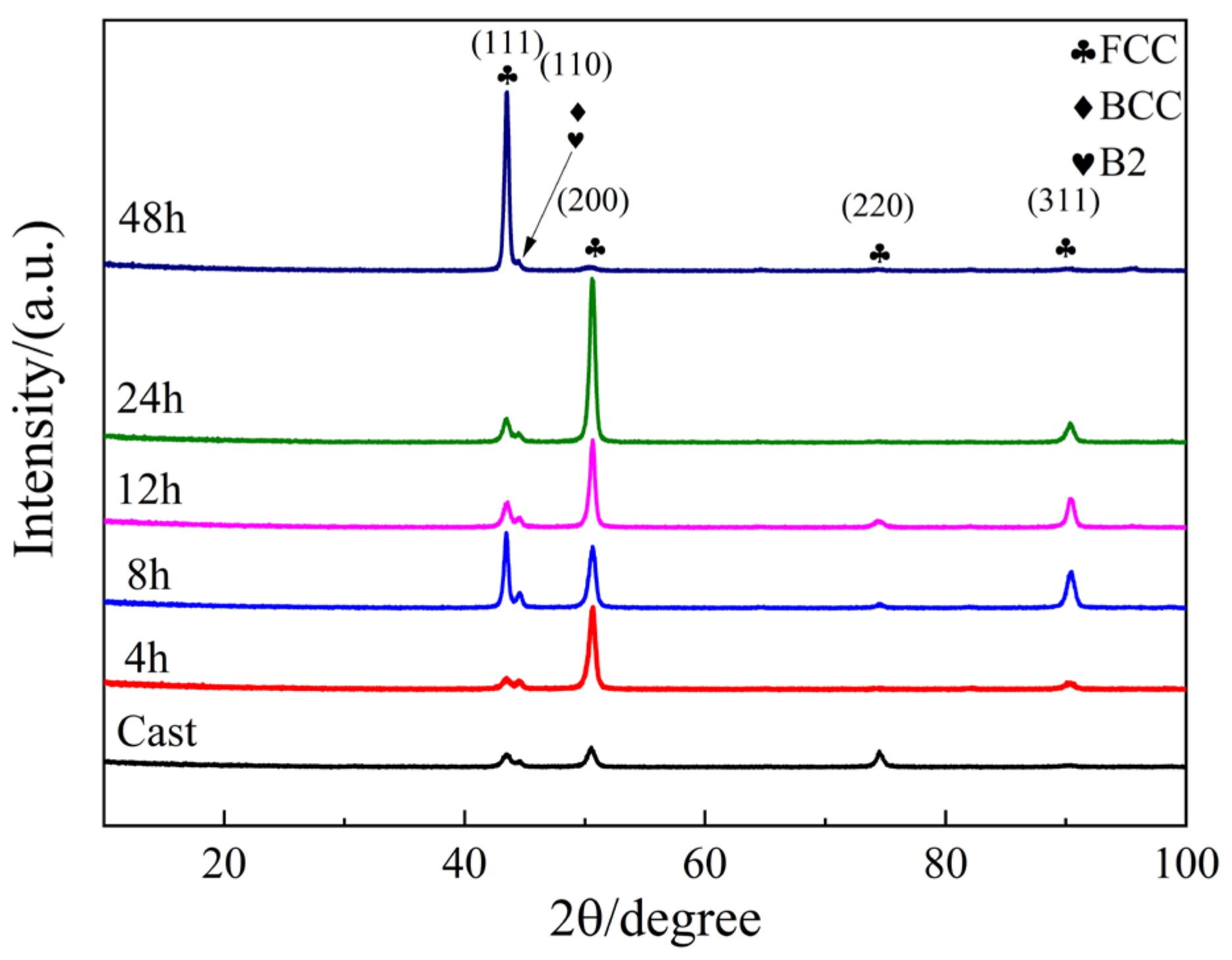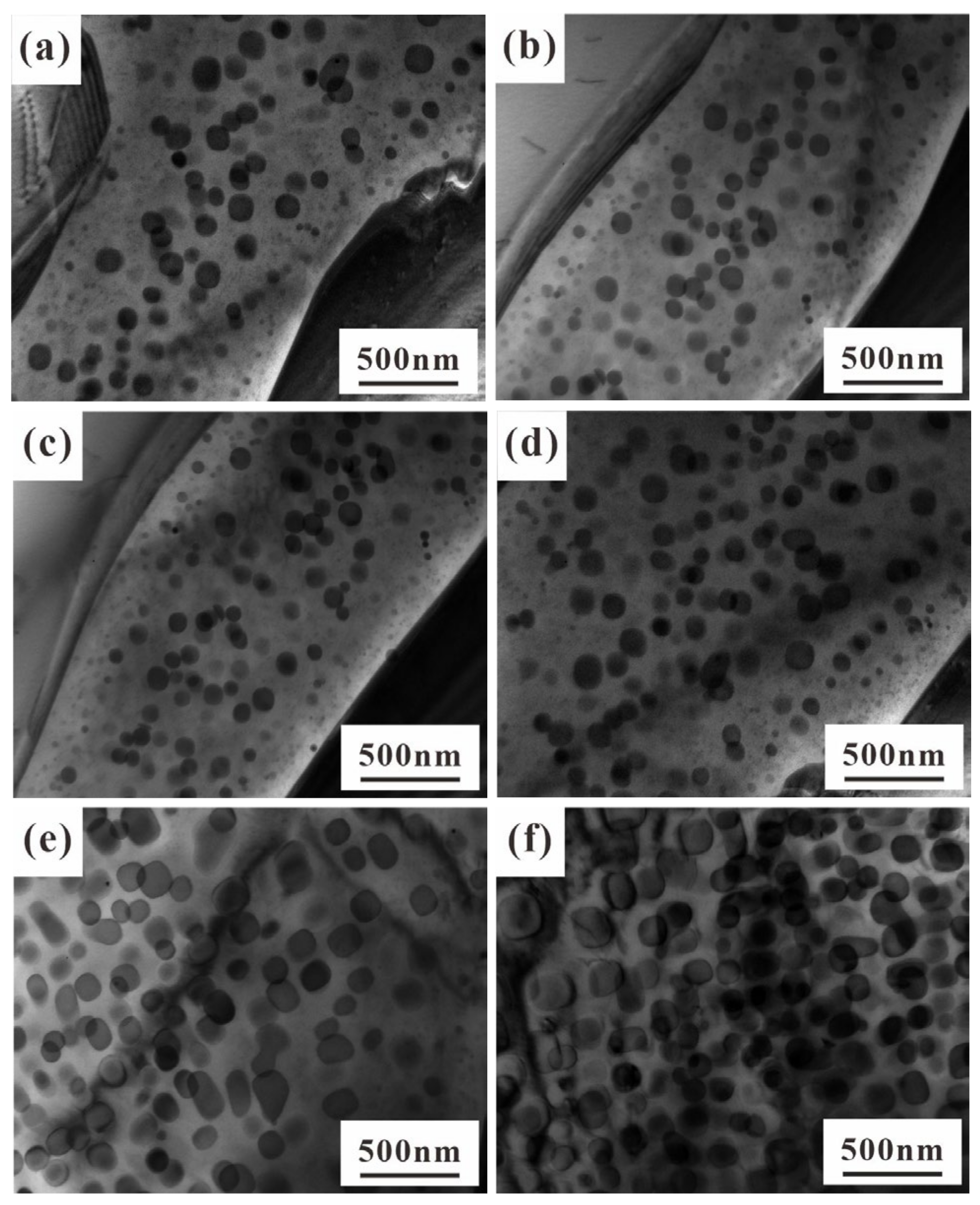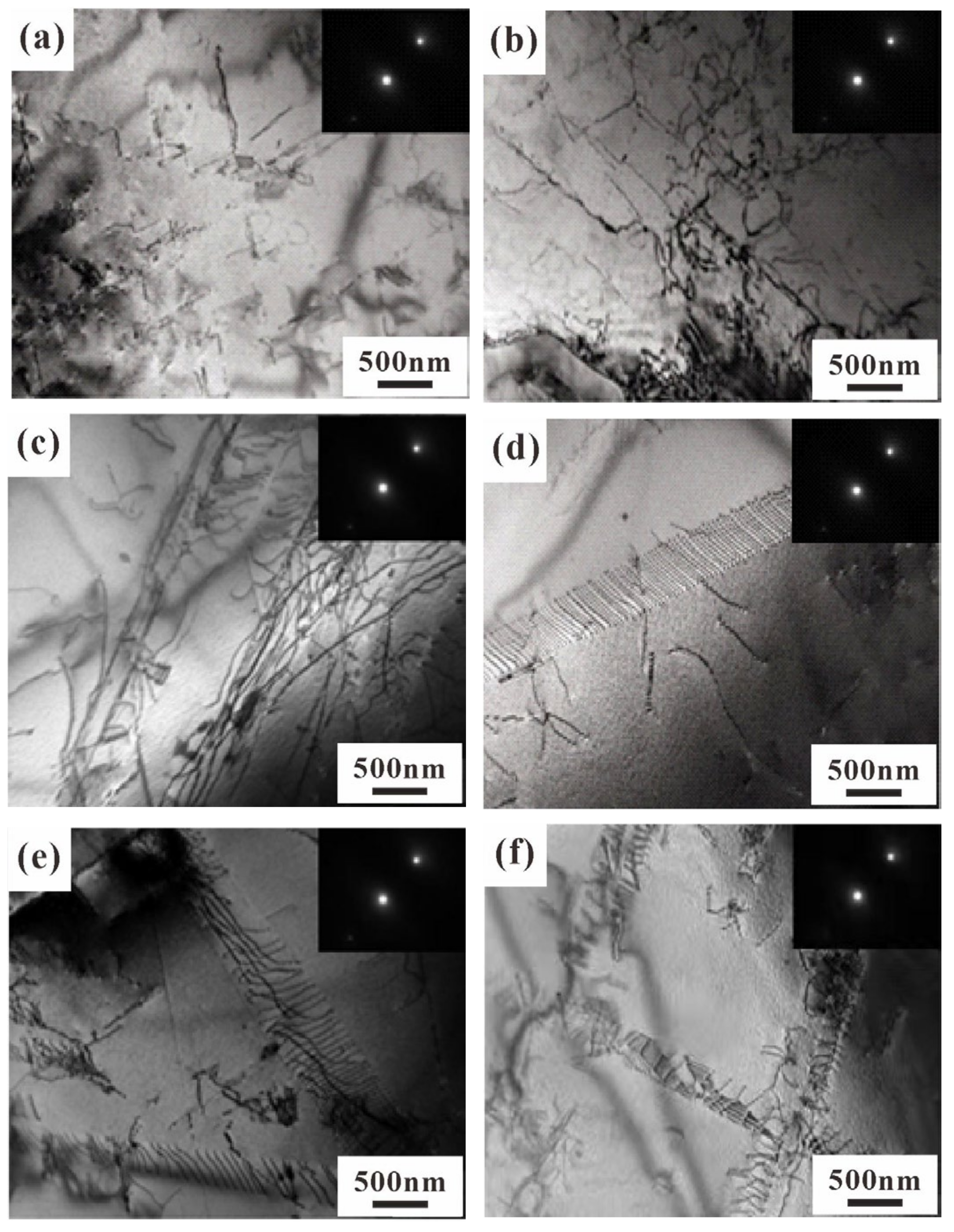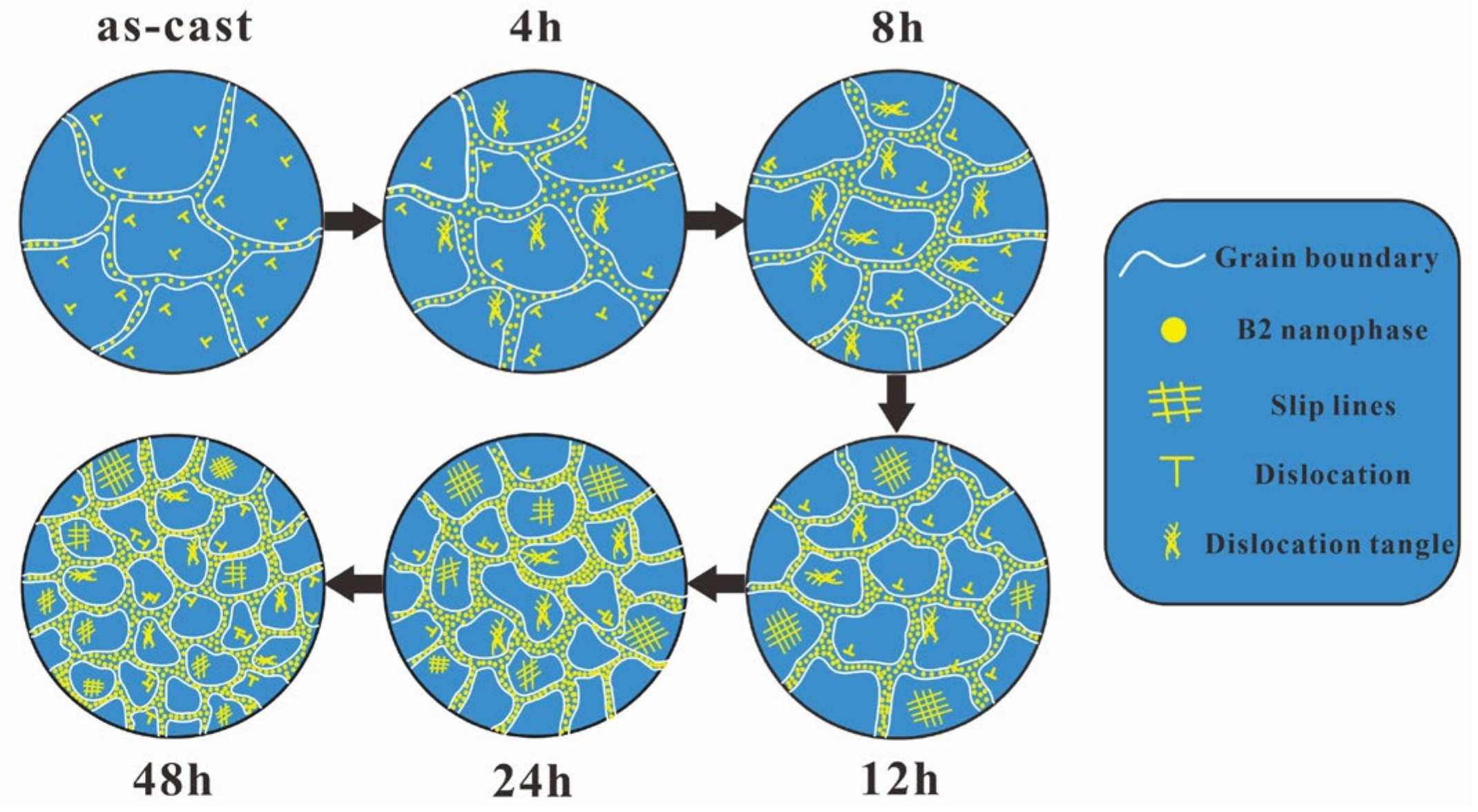Effect of Cryogenic Treatment on Microstructure and Mechanical Properties of Al0.6CrFe2Ni2 Dual-Phase High-Entropy Alloy
Abstract
1. Introduction
2. Experimental Materials and Methods
3. Results and Discussion
3.1. The Dependence of Phase Composition on Cryogenic Treatment
3.2. Effect of Cryogenic Treatment on Microstructure
3.3. Effect of Cryogenic Treatment on Compression Performance
4. Conclusions
- (1)
- Cryogenic treatment can significantly refine the equiaxed grain size of the Al0.6CrFe2Ni2 HEA, and the longer the cryogenic treatment time, the smaller the equiaxed grain size. When the cryogenic treatment time is 48 h, the average size of equiaxed grains decreases to 44.6 μm, which is 46.5% lower than that of the as-cast alloy.
- (2)
- The Al0.6CrFe2Ni2 HEA is composed of FCC phases, BCC inter-dendritic phases, and spherical B2 nanophases embedded in the BCC inter-dendritic region. The number and size of the B2 nanophases increase significantly with the increase in the cryogenic treatment time, which is related to the significant increase in dislocation density caused by volume shrinkage and plastic deformation of the alloy during cryogenic treatment.
- (3)
- The refinement of equiaxed grains, the large precipitation of nanophases, and the appearance of cross-slips and stacking faults caused by cryogenic treatment give the Al0.6CrFe2Ni2 HEA excellent strength and ductility. The 48 h cryogenically treated alloy shows a yield strength of 390 MPa, which is 39.3% higher than that of the as-cast alloy.
Author Contributions
Funding
Data Availability Statement
Conflicts of Interest
References
- Klimova, M.; Stepanov, N.; Shaysultanov, D.; Chernichenko, R.; Yurchenko, N.; Sanin, V.; Zherebtsov, S. Microstructure and mechanical properties evolution of the Al, C-containing CoCrFeNiMn-type high-entropy alloy during cold rolling. Materials 2018, 11, 53. [Google Scholar] [CrossRef] [PubMed]
- Xiong, T.; Zheng, S.; Pang, J.; Ma, X. High-strength and high-ductility AlCoCrFeNi2.1 eutectic high-entropy alloy achieved via precipitation strengthening in a heterogeneous structure. Scr. Mater. 2020, 186, 336–340. [Google Scholar] [CrossRef]
- Du, X.; Huo, X.; Chang, H.; Li, W.; Duan, G.; Huang, J.; Wu, B.; Zou, N.; Zhang, L. Superior strength-ductility combination of a Co-rich CoCrNiAlTi high-entropy alloy at room and cryogenic temperatures. Mater. Res. Express 2020, 7, 034001. [Google Scholar] [CrossRef]
- Zhang, H.; Zhao, Y.; Huang, S.; Zhu, S.; Wang, F.; Li, D. Manufacturing and analysis of high-performance refractory high-entropy alloy via selective laser melting (SLM). Materials 2019, 12, 720. [Google Scholar] [CrossRef]
- Ao, F.; Cao, Y.; Liu, Y.; Xu, S. Microstructure and mechanical properties of novel lightweight TaNbVTi-based refractory HEAs. Materials 2022, 15, 355. [Google Scholar]
- Li, Y.; Liang, H.; Nie, Q.; Qi, Z.; Deng, D.; Jiang, H.; Cao, Z. Microstructures and wear resistance of CoCrFeNi2V0.5Tix high-entropy alloy coatings prepared by laser cladding. Crystals 2020, 10, 352. [Google Scholar] [CrossRef]
- Wu, M.; Chen, K.; Xu, Z.; Li, D. Effect of Ti addition on the sliding wear behavior of AlCrFeCoNi high-entropy alloy. Wear 2020, 462, 203493. [Google Scholar] [CrossRef]
- Fu, A.; Liu, B.; Lu, W.; Liu, B.; Li, J.; Fang, Q.; Li, Z.; Liu, Y. A novel supersaturated medium entropy alloy with superior tensile properties and corrosion resistance. Scr. Mater. 2020, 186, 381–386. [Google Scholar] [CrossRef]
- Wu, P.; Gan, K.; Yan, D.; Fu, Z.; Li, Z. A non-equiatomic FeNiCoCr high-entropy alloy with excellent anti-corrosion performance and strength-ductility synergy. Corros. Sci. 2021, 183, 109341. [Google Scholar] [CrossRef]
- Liu, C.; Peng, W.; Jiang, C.S.; Gou, H.; Tao, J.; Deng, X.; Chen, Z. Composition and phase structure dependence of mechanical and magnetic properties for AlCoCuFeNix high entropy alloys. J. Mater. Sci. Technol. 2019, 35, 1175–1183. [Google Scholar] [CrossRef]
- Zhang, Y.; Qi, H.; Qu, Y.; Li, C.Z.; Lv, Q.; Li, Z.; Li, R.; Tan, B.; Tian, C.; Nie, S. The effect of TiC addition on the microstructure and mechanical properties of Al0.6CrFe2Ni2 high entropy alloys. SN Appl. Sci. 2020, 2, 493. [Google Scholar] [CrossRef]
- Tong, Z.; Ren, X.; Jiao, J.; Zhou, W.; Ren, Y.; Ye, Y.; Larson, E.A.; Gu, J. Laser additive manufacturing of FeCrCoMnNi high-entropy alloy: Effect of heat treatment on microstructure, residual stress and mechanical property. J. Alloys Compd. 2019, 785, 1144–1159. [Google Scholar] [CrossRef]
- Xie, J.; Zhang, S.; Sun, Y.; Hao, Y.; An, B.; Li, Q.; Wang, C. Microstructure and mechanical properties of high entropy CrMnFeCoNi alloy processed by electopulsing-assisted ultrasonic surface rolling. Mater. Sci. Eng. A 2020, 795, 140004. [Google Scholar] [CrossRef]
- Masemola, K.; Popoola, P.; Malatji, N. The effect of annealing temperature on the microstructure, mechanical and electrochemical properties of arc-melted AlCrFeMnNi equi-atomic high entropy alloy. J. Mater. Res. Technol. 2020, 9, 5241–5251. [Google Scholar] [CrossRef]
- Shen, Q.; Kong, X.; Chen, X. Significant transitions of microstructure and mechanical properties in additively manufactured Al–Co–Cr–Fe–Ni high-entropy alloy under heat treatment. Mater. Sci. Eng. A 2021, 815, 141257. [Google Scholar] [CrossRef]
- Mehranpour, M.; Shahmir, H.; Nili-Ahmadabadi, M. CoCrFeNiMn high entropy alloy microstructure and mechanical properties after severe cold shape rolling and annealing. Mater. Sci. Eng. A 2020, 793, 139884. [Google Scholar] [CrossRef]
- Malatji, N.; Lengopeng, T.; Pityana, S.; Popoola, A.P.I. Effect of heat treatment on the microstructure, microhardness, and wear characteristics of AlCrFeCuNi high-entropy alloy. Int. J. Adv. Manuf. Technol. 2020, 111, 1–9. [Google Scholar] [CrossRef]
- Munitz, A.; Salhov, S.; Guttmann, G.; Derimow, N.; Nahmany, M. Heat treatment influence on the microstructure and mechanical properties of AlCrFeNiTi0.5 high entropy alloys. Mater. Sci. Eng. A 2019, 742, 1–14. [Google Scholar] [CrossRef]
- Li, D.; He, W.; Zhang, X.; Xiao, M.; Li, S.; Zhao, K.; Yang, M. Effects of traditional heat treatment and a novel deep cryogenic treatment on microstructure and mechanical properties of low-carbon high-alloy martensitic bearing steel. J. Iron Steel Res. Int. 2021, 28, 370–382. [Google Scholar] [CrossRef]
- Wannaprawat, N.; Tuchinda, K. Study of deep cryogenic treatment process effect on microstructure and properties of CuBeZr alloy. Key Eng. Mater. 2020, 841, 335–339. [Google Scholar] [CrossRef]
- Cardoso, P.H.S.; Israel, C.L.; da Silva, M.B.; Klein, G.A.; Soccol, L. Effects of deep cryogenic treatment on microstructure, impact toughness and wear resistance of an AISI D6 tool steel. Wear 2020, 456, 203382. [Google Scholar] [CrossRef]
- Li, C.; Qu, Y.; Zhang, Y.; Lv, Q.; Qi, H. Effect of deep cryogenic treatment on the microstructure and mechanical properties of AlCrFe2Ni2 high-entropy alloy. Mater. Res. Express 2020, 7, 036504. [Google Scholar] [CrossRef]
- Zhang, W.; Bai, P.; Yang, J.; Xu, H.; Dang, J.; Du, Z. Tensile behavior of 3104 aluminum alloy processed by homogenization and cryogenic treatment. Trans. Nonferrous Met. Soc. China 2014, 24, 2453–2458. [Google Scholar] [CrossRef]
- Bhale, P.; Shastri, H.; Mondal, A.K.; Masanta, M.; Kumar, S. Effect of deep cryogenic treatment on microstructure and properties of AE42 Mg alloy. J. Mater. Eng. Perform. 2016, 25, 3590–3598. [Google Scholar] [CrossRef]
- Li, L.; Chen, H.; Fang, Q.; Li, J.; Liu, F.; Liu, Y.; Liaw, P.K. Effects of temperature and strain rate on plastic deformation mechanisms of nanocrystalline high-entropy alloys. Intermetallics 2020, 120, 106741. [Google Scholar] [CrossRef]
- Singh, K.S.; Parashar, A. Effect of lattice distortion and nanovoids on the shock compression behavior of (Co-Cr-Cu-Fe-Ni) high entropy alloy. Comput. Mater. Sci. 2022, 209, 111402. [Google Scholar] [CrossRef]
- Liu, J.; Chen, C.; Feng, Q.; Fang, X.; Wang, H.; Liu, F.; Lu, J.; Raabe, D. Dislocation activities at the martensite phase transformation interface in metastable austenitic stainless steel: An in-situ TEM study. Mater. Sci. Eng. A 2017, 703, 236–243. [Google Scholar] [CrossRef]







Disclaimer/Publisher’s Note: The statements, opinions and data contained in all publications are solely those of the individual author(s) and contributor(s) and not of MDPI and/or the editor(s). MDPI and/or the editor(s) disclaim responsibility for any injury to people or property resulting from any ideas, methods, instructions or products referred to in the content. |
© 2023 by the authors. Licensee MDPI, Basel, Switzerland. This article is an open access article distributed under the terms and conditions of the Creative Commons Attribution (CC BY) license (https://creativecommons.org/licenses/by/4.0/).
Share and Cite
Xie, S.; Lv, Q.; Zhang, W.; Qu, Y.; Qi, H.; Yu, B.; Li, R.; Li, G.; Yang, F. Effect of Cryogenic Treatment on Microstructure and Mechanical Properties of Al0.6CrFe2Ni2 Dual-Phase High-Entropy Alloy. Metals 2023, 13, 195. https://doi.org/10.3390/met13020195
Xie S, Lv Q, Zhang W, Qu Y, Qi H, Yu B, Li R, Li G, Yang F. Effect of Cryogenic Treatment on Microstructure and Mechanical Properties of Al0.6CrFe2Ni2 Dual-Phase High-Entropy Alloy. Metals. 2023; 13(2):195. https://doi.org/10.3390/met13020195
Chicago/Turabian StyleXie, Sichen, Qingyao Lv, Wei Zhang, Yingdong Qu, Hao Qi, Bo Yu, Rongde Li, Guanglong Li, and Fei Yang. 2023. "Effect of Cryogenic Treatment on Microstructure and Mechanical Properties of Al0.6CrFe2Ni2 Dual-Phase High-Entropy Alloy" Metals 13, no. 2: 195. https://doi.org/10.3390/met13020195
APA StyleXie, S., Lv, Q., Zhang, W., Qu, Y., Qi, H., Yu, B., Li, R., Li, G., & Yang, F. (2023). Effect of Cryogenic Treatment on Microstructure and Mechanical Properties of Al0.6CrFe2Ni2 Dual-Phase High-Entropy Alloy. Metals, 13(2), 195. https://doi.org/10.3390/met13020195






